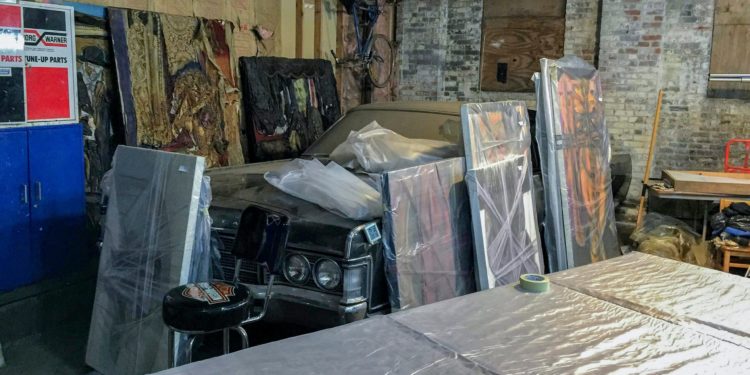Local
A 2017 discovery and a few years of research are culminating in an exhibit opening in May.
After fading into obscurity, the late artist Francis Hines is gaining new attention after a car mechanic rescued hundreds of his paintings from a dumpster in Connecticut.
Hines, an abstract expressionist, garnered some recognition in 1980 by using fabric to wrap the arch in New York City’s Washington Square in an intricate crisscross pattern. But he kept a low profile and drifted out of the art world’s spotlight, passing away in 2016.
The trove of paintings, most using his signature wrapping style, was found a year later — and that’s where the artist’s path to rediscovery began.
An exhibit of the found art will open May 5 at the Hollis Taggart galley in Southport, Connecticut, which is known for showing the works of lost or forgotten artists. A smaller exhibit will be shown simultaneously at the gallery’s flagship location in New York City.
Hines made a good living as an illustrator for magazines and the G. Fox department store, and his personal art was about the process, not about selling or displaying his work, said Peter Hastings Falk, an art historian who is helping curate the exhibit.
So for decades, once he finished a piece, he would ship it from his New York studio to a barn he was renting in Watertown, Connecticut, where it would be wrapped in plastic and stored.
“For him it was like, ‘OK , I did that, that was cool, I’ll put it away,’” Falk said. “Once he was done, he was done and on to the next project. And if you don’t have a gallery selling your work, it’s going to pile up a lot.”
Taggart, the gallery’s president and an art collector, said he’d “never seen anything like it before.”
“In today’s art world there is a definite interest in different mediums — textiles, fabrics and ceramics — people are trying to find new and innovative ways to present contemporary art,” Taggart said. “He did that back in the ’80s. He was somewhat of a visionary.”
Hines used his wrapping technique in other installations, including at JFK Airport and the Port Authority bus terminal. In his sculptures and paintings, he stretched fabric or other material over or through them to create a sense of tension and dynamic energy, Taggart said.
Hines’ work remained stored in Watertown until after his death at the age of 96, when his estate decided to dispose of the massive collection because the barn’s owner was selling the property.
Two 40-yard (37-meter) dumpsters filled with sculptures and paintings had already been hauled away to a landfill when Jared Whipple, a Waterbury-area mechanic and skateboard enthusiast, got a call from a friend, George Martin, who was helping dispose of the art.
Because some of the paintings included images of car parts, Martin thought Whipple might like them.
Whipple figured he could use the art in a Halloween display, or to hang at his indoor skateboarding facility. When he began taking the plastic covering off the pieces, he started to realize he’d stumbled onto something special.
“But at the same time, you would never think there was any type of importance or value there, because they are all in a dumpster,” he said.
Most of the works were signed F. Hines, but Whipple eventually found one small canvas, painted in 1961, that included the artist’s full name: “Francis Mattson Hines.”
That’s when the Google searching began and he went down what he called a “rabbit hole” for 4 1/2 years learning about art and knocking on gallery doors, he said.
That research led him back to the 1980 Washington Square arch installation, to a book about Hines by his wife, and eventually to Falk and Hines’ two sons, one of whom, Jonathan Hines, is also an artist.
Jonathan Hines is now working with Whipple, adding other pieces of his father’s work to the exhibit.
“I think that it is fate that Jared would discover my father’s work,” Jonathan Hines said. “It had to be someone from outside the art world. Had I not decided to throw out the art, none of this would have happened.”
The family knew the artwork had value — but without critical recognition, they made the painful decision to abandon it all, said Falk, the art historian.
Hines’ paintings, most of which are owned by Whipple, will be offered for sale at the exhibit, with the larger pieces expected to sell for about $20,000 each, Falk said.
But Whipple says it’s not about getting rich from something that was nearly lost to a landfill.
“I want to get this artist recognition,” he said. “And I’d like to get him into some major museums maybe, just get him the recognition he deserved.”
Falk said Hines should be remembered as an important American artist for how he fits in the timeline of abstract expressionism and his unique twist on the technique of wrapping. The fact that his work was nearly lost forever, he said, merely helps shine a light on it.
“Now we’re focused only on the art, not on the fact that it was thrown away, not that it was discovered by a skateboarder car mechanic, not on anything else,” Falk said. “Just the art on its own merit.”








